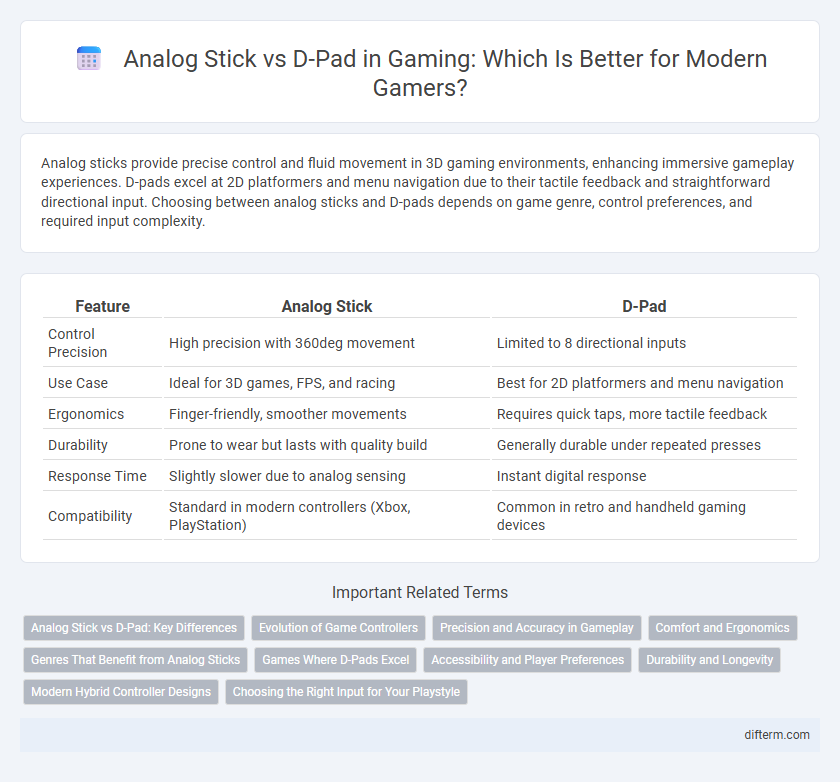Analog sticks provide precise control and fluid movement in 3D gaming environments, enhancing immersive gameplay experiences. D-pads excel at 2D platformers and menu navigation due to their tactile feedback and straightforward directional input. Choosing between analog sticks and D-pads depends on game genre, control preferences, and required input complexity.
Table of Comparison
| Feature | Analog Stick | D-Pad |
|---|---|---|
| Control Precision | High precision with 360deg movement | Limited to 8 directional inputs |
| Use Case | Ideal for 3D games, FPS, and racing | Best for 2D platformers and menu navigation |
| Ergonomics | Finger-friendly, smoother movements | Requires quick taps, more tactile feedback |
| Durability | Prone to wear but lasts with quality build | Generally durable under repeated presses |
| Response Time | Slightly slower due to analog sensing | Instant digital response |
| Compatibility | Standard in modern controllers (Xbox, PlayStation) | Common in retro and handheld gaming devices |
Analog Stick vs D-Pad: Key Differences
The analog stick offers 360-degree movement, allowing for precise control and fluid character navigation, whereas the D-pad provides discrete directional inputs, typically limited to eight directions. Analog sticks excel in 3D gaming environments by enabling nuanced speed and direction changes, while D-pads are preferred for 2D games and menu navigation due to their crisp, tactile feedback. Understanding these key differences helps players select the optimal controller component based on game genre and playstyle preferences.
Evolution of Game Controllers
The evolution of game controllers highlights the shift from traditional D-pads to advanced analog sticks, enhancing precision and 360-degree movement in gaming. Analog sticks provide greater sensitivity and control for complex gameplay, especially in 3D environments, while D-pads remain favored for 2D platformers and fighting games. Innovations in controller design continue to blend these input methods, optimizing player experience across diverse gaming genres.
Precision and Accuracy in Gameplay
Analog sticks offer greater range of motion and analog input sensitivity, delivering nuanced control essential for precise aiming in first-person shooters and smooth character movement in 3D environments. D-pads provide discrete directional inputs that excel in platformers and fighting games, enabling high accuracy with quick, deliberate taps for combo execution. Precision in gameplay is largely influenced by the type of input, with analog sticks favoring fluid accuracy and D-pads supporting exact digital commands.
Comfort and Ergonomics
Analog sticks offer superior comfort and ergonomics for extended gaming sessions due to their natural thumb movement and reduced strain on the joints. D-pads, while precise for certain game genres, can cause finger fatigue and discomfort over time because of their limited range of motion and rigid design. Ergonomic controllers often prioritize analog sticks to enhance user comfort and minimize repetitive strain injuries.
Genres That Benefit from Analog Sticks
Genres such as first-person shooters, racing games, and action-adventure titles benefit significantly from analog sticks due to their precise 360-degree movement control and variable input sensitivity. Analog sticks enable smoother character navigation, camera manipulation, and responsive vehicle handling, which are crucial for immersive gameplay in these genres. Their ability to provide analog input allows for more nuanced control compared to the discrete directional inputs of a D-pad.
Games Where D-Pads Excel
D-pads excel in retro and 2D platformer games where precise directional input is crucial, such as in classic titles like Super Mario World and fighting games like Street Fighter. Their distinct tactile feedback allows for accurate diagonal movements and swift directional changes, essential for executing combos and timing jumps. Unlike analog sticks, d-pads provide consistent digital input that enhances performance in pixel-perfect control scenarios.
Accessibility and Player Preferences
Analog sticks offer greater precision and fluidity, enhancing accessibility for players with limited hand dexterity by allowing smoother, more intuitive control. In contrast, D-pads provide discrete directional inputs preferred by players seeking accuracy in 2D platformers and fighting games. Player preferences often depend on game genre and physical ability, with some prioritizing ergonomic ease and others favoring input responsiveness.
Durability and Longevity
Analog sticks feature complex internal components that can wear out faster due to continuous pressure and directional inputs, often leading to drift issues over time. D-pads, built with simpler mechanical switches, typically offer superior durability and longer lifespan in rigorous gaming conditions. Gamers seeking reliable control in long-term play often prefer D-pads for their consistent responsiveness and reduced maintenance needs.
Modern Hybrid Controller Designs
Modern hybrid controller designs integrate both analog sticks and D-pads to offer versatile input options catering to diverse gaming genres. Analog sticks provide precise 360-degree movement essential for first-person shooters and open-world exploration, while D-pads enable accurate directional controls ideal for platformers and fighting games. This combination maximizes player control and comfort, enhancing overall gameplay experience across multiple game types.
Choosing the Right Input for Your Playstyle
Analog sticks provide precise, fluid control ideal for fast-paced shooters and racing games, allowing nuanced movements and quick directional changes. D-pads offer crisp, tactile feedback perfect for platformers and retro-style games where discrete inputs and simple directional control are essential. Selecting between analog sticks and D-pads depends on your playstyle preferences and the game genre, ensuring optimal responsiveness and comfort during gameplay.
analog stick vs D-pad Infographic

 difterm.com
difterm.com